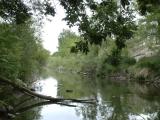As a young boy, in the the1950s, I walked barefoot in the moss and mud on the banks of the Portneuf River, a tributary of the large, better-known Snake River, in Southeastern Idaho. The river was lined on both sides, with trees and bushes overhanging the banks. Big Oaks, Maple trees, Goldenraintee, Hawthorne Birchc,h and Dogwood trees. The trees stood with willows and bushes thick at their sides. Occasional lilac bushes brought their deep blue to the natural cover.
Our family’s home sat right on the bank of the river, and with the open window, my upstairs bedroom brought the sound of the flowing water, birds, and various river sounds. Large Oak trees rose from the bank below, and the leaves from the upper branches would brush the house and window with the movement of the wind.
Winter by the River
With the leaves gone and the water lowered, everything changed. The ice layered up the banks, and, in some places, only ice could be seen. Often the branches of the willows and trees were covered with white crystal-like coverings. Some would ice skate, but this was something I was fearful of doing.
Summers by the River
The water was higher than in the winter with all the runoff from the snow-topped mountains that feed the river. My Huckleberry Finn experience included rafts built from trees and fishing as we would float downstream. Our house was in the middle of a residential section near the town of Pocatello, but going downstream on a raft, with the tree and bush-lined banks, was like being in another world.
Fishing from the raft was done with a traditional fishing pole, but fishing from the shore, mostly in my back yard, was different. Instead of a pint or quart glass bottle, no bars or hooks were used. My mother used the same Kerr brand bottles, referred to as Mason Jars, to bottle raspberries, peaches, cherries, and other items, by sealing them in a boiling kettle bath. Raspberries were my favorite.




